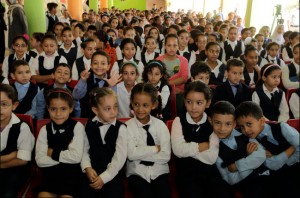By Naoufel Cherkaoui in Rabat
for Magharebia

Each year, 30,000 Moroccan students leave school before completing their education. Some quit class at the primary level
Despite reforms, Morocco still struggles with equal access to education and a high dropout rate.
Morocco is determined to fix the biggest problems in its educational system: unequal access to schooling and the high number of dropouts.
“Education is a fundamental right,” said National Council for Human Rights (CNDH) head Driss El Yazami, whose organisation just co-hosted an international conference aimed at finding solutions.
Illiteracy prevents the “spread of the culture of citizenship and human rights, and the implementation of democracy”, he told attendees of the December 6th-7th event in Rabat.
El Yazami admitted that over the past 15 years, reforms to Morocco’s educational system had failed to provide universal “access to high quality education, especially for children in semi-urban and rural areas”.
Many pupils in rural areas find it difficult to get to schools, which can be far from their villages. The government has made efforts to build schools in rural areas and has even launched partnerships to provide boarding schools, but these measures fall short, political analyst Jamal Farhani said.
Some 30,000 Moroccan students leave primary and secondary school every year.
This degree of attrition – and the educational inequality it creates – hinders development in the kingdom, confirmed Ilham Lagrich. She heads the Rural Girls Education Supporting Committee (CSSF), which helped organise the forum.
“If we compare the index measuring inequality in Morocco with that of other countries in the Mediterranean basin, of 11 countries, Morocco is lagging. Our country is ranked second to last – at the same level as Mauritania and Yemen,” she said..
“Morocco is considered, according to the UNESCO report on education, among the 21 countries with the worst educated students, alongside Mauritania and other sub-Saharan countries. In fact, less than 35% of students reach the fourth year of primary school,” Lagrich lamented.
While Morocco has “made remarkable efforts in the last two decades to increase the number of new enrolments”, the educational system “was not keen on providing quality programmes or structures”, said Mohammed Dich, a member of the Regional Committee for Human Rights in Fes and Meknes.
One problem is class size, he said.
“I cannot imagine a quality educational program in light of overcrowded classrooms,” he told Magharebia.
“The number of pupils per class could be up to 56, and in degrading conditions,” the rights activist added. “We also cannot also talk about a good school system in light of the shortfall in the number of teachers.”
To minimize drop-outs, Dich said schools should “respect the dignity of students and not stifle creativity or tolerate discrimination”.
He also said the government should create favourable conditions for education and expand programs to help poor families and those in rural areas.







